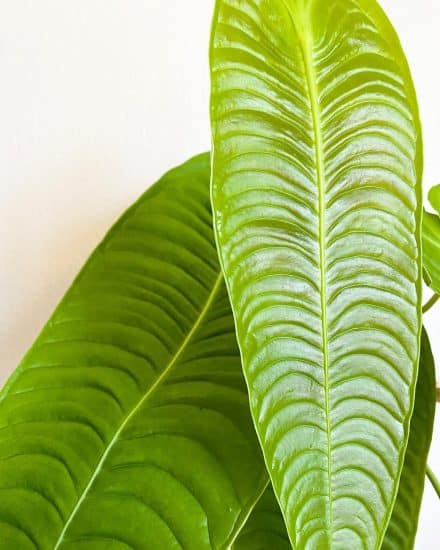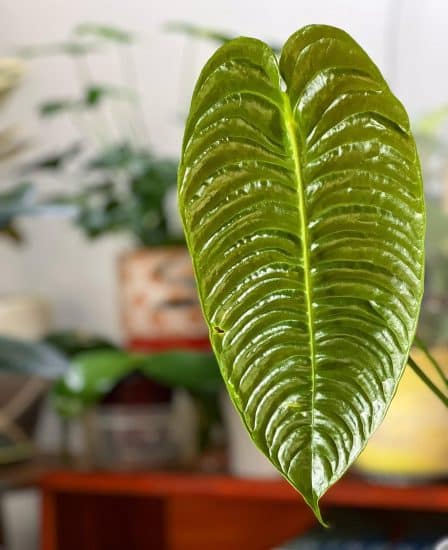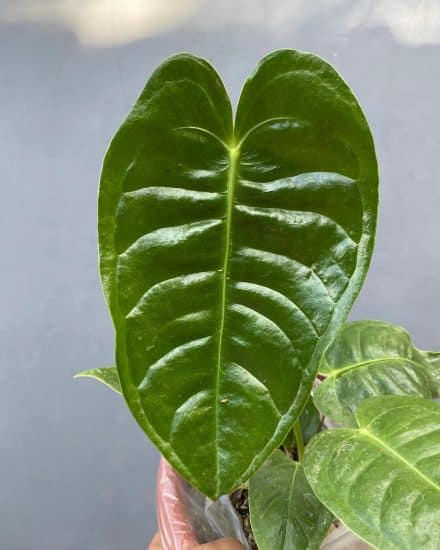Anthurium veitchii (‘King Anthurium’) has been cultivated and hybridized for hundreds of years and what was once a rare houseplant is now becoming widely available.
This plant features unique corrugation/ribbing from its veins and large, broad leaves that reflect beautiful green light throughout a room.
We’ll cover everything you need to know to take care of your Anthurium veitchi, including how to propagate and deal with the most common issues which come up.
Table of Contents
Anthurium Veitchii Care Guide
History, habitat, and characteristics

Anthurium veitchii, or King Anthurium, is a species of flowering plant native to Colombia. It was first bred and cultivated by Scottish horticulturist John Veitch in the mid-1800s and continues to be a popular choice among modern gardeners and indoor plant enthusiasts alike.
In the wild, this epiphyte species grows up high in the canopy of trees. It’s a slow-growing plant that may take several months to establish, but once it does, its beautiful large leaves will last for a long time.
Anthurium veitchii has a continuous rhizomatous stem structure and glossy dark green leaves with distinct silver veins. Its leaf shape ranges from heart-shaped when young to elongated and spear-like as it matures with predominant midribs and visible veins – taking on its signature “corrugated” look. I
Indoors? Leaves might grow as large as three feet.
True to its roots which reach back to underneath the misty rainforest canopy, Anthurium veitchii prefers humid warmth to thrive. Unlike those ancient grounds: it’s pretty happy in a basket, too.
Anthurium veitchii – narrow vs wide form

If you’re shopping for Anthurium veitchii and notice these options, they’re actually pretty intuitive. You’ll notice the leaves of Anthurium veitchii have ribbing or corrugation. This corrugation can either be close together or spread further apart.
Narrow form Anthurium veitchii might also spot a new leaf or recent plant growth. The care for both plants is exactly the same, and often it comes down to whether you’re buying a mature or juvenile plant.
Light

Anthurium veitchii prefers bright, filtered indirect light to look its best, much like it would get in the wild.
Knowing how to tell if Anthurium veitchii is not getting enough or too much light is essential. If the leaves look dull and lifeless, good sign that the light is too low. On the other hand, if the leaves appear pale or yellow with chlorotic stains, the plant may be getting too much light and needs to be moved away from the window.
If you’re using supplemental or artificial lights, opt for LED lights. These will provide enough light without overheating the plant and causing leaf burns. You’ll also save electricity.
Tips:
- When keeping the plant indoors, use an east-facing window for ideal light conditions, or close to a northern window.
- As an epiphytic plant, Anthurium prefers bright, filtered light (meaning: not direct). Sheer curtains can be on a south/west-facing window.
- If the leaves start yellowing or falling off this is a good sign that your King Anthurium isn’t getting enough light. Too much light and you’ll see crispy edges.
Water
My favorite method for watering King Anthurium is to pour water over the soil until it drains from the bottom of the pot. Think of it as a pour-over for your plant! This way, you ensure that the entire root system is hydrated.
How frequently you water depends on both the climate and if you’ve planted your Anthurium veitchii in soil or moss in an orchid basket. If it’s in soil, typically water once a week in the spring and summer, and every two weeks in the fall and winter. Sphagnum moss mixes should be watered as it dries out.
Tips:
- Monitor the soil and water when the top inch of soil has become dry.
- Signs of overwatering include yellowing or browning of lower leaves, wilting of upper leaves, root rot or a foul odor coming from soil.
- Underwatering can possibly cause wilting and drooping of leaves, turning them a lighter shade of green. Underwatering can also cause the leaves to become brown, brittle and crisp around the edges.
- Drench the soil to ensure the entire potting mixture is evenly wet.
Temperature and humidity
Anthurium veitchii prefers warm temperatures, between 65-77 degrees Fahrenheit, but if it gets up to 85 degrees Fahrenheit it should still be okay, especially briefly.
Humidity is key! Aim for an environment similar to its native habitat, around 55-65% humidity, depending on your home’s local conditions. If you aren’t sure how humid it is, you can always consider a hygrometer which will give you an exact reading. If you have a smart thermostat, many of these provide a general reading as well.
I like to check my Anthurium veitchii’s humidity levels every other day, making sure it is above 55%. In the morning I’ll switch on a humidifier for a few hours until it reaches the ideal humidity level of 65%. Once it’s there, the plant usually stays pretty happy, so I switch off the humidifier so the air doesn’t get too damp and stagnant.
Let’s talk a little more about humidity. In its native range, Anthurium veitchii is used to high humidity levels, around 60-100%. This can be pretty difficult to achieve indoors while keeping things comfy for the non-plants in your space (like you.
Solution?
Consider making a moss terrarium to create a microclimate for your plant.
If that seems a bit too adventurous, you can always group plants together. In a cluster, they’ll act as an insulator and increase the humidity of the local environment.
Soil and planting

Anthurium veitchii, as an epiphyte, really thrives best with a loose soil. Normally we’d offer a whole list of possible ingredients to consider, but for King Anthurium I really want to highlight two.
Orchid bark. Commonly used for epiphytic orchids, this material is fantastic for any plant that in nature grows on other plants or trees. Orchid bark is, like it sounds, made from the bark of trees and helps recreate the symbiotic interface between tree and root but in your home. This material introduces beneficial fungi into your potting soil and lightens up the potting mix to increase drainage. Remember, these tropical plants typically grab their moisture from the air (and lots of it!).
Perlite (or LECA). Perlite is basically volcano glass and is made naturally in a similar way to LECA. It’s super-heated which causes the material to expand, as it expands it becomes more and more porous making it a great material for lightening up soil for delicate roots, retaining water, and creating an overall well-draining growth medium for epiphytic plants. Many people use peat moss instead.
Fertilizer
For fertilizer, a 50% diluted balanced liquid houseplant fertilizer can be applied monthly during spring and summer, but should not be used during fall and winter. Always water before fertilizing.
Propagation guide

Unlike many indoor plants, King Anthurium should be propagated by division and not a stem-cutting method. Don’t worry, it’s actually super easy and can be done naturally when re-potting a mature plant.
As you take it out of its current pot you’ll want to remove away as much of the soil or medium as possible.
You’ll separate the roots into multiple sections, ensuring that each divided section has a healthy root system.
Anthurium plants typically send up babies with their own root structures that can be untangled. You may have to use some effort and lose some of the roots, but normally they’re sturdy and it should be a very intuitive project.
Propagating Anthurium veitchii is typically a great experience because unlike with stem propagation, you immediately know that you’re successful and can distribute your plant right away. Division generally is my favorite method of propagation because the root structures you’re working with are already well-established and you just replant directly into potting soil.
Common issues

The most common issues you’ll see with Anthurium veitchii are the same as you’ll find with any tropical plant you’re trying to grow indoors. Fortunately, this means most of these problems are well understood and have pretty simple solutions.
Yellowing Leaves
Caused by: Water issues (too much or too little water), light issues (direct sunlight).
Solution: Move Anthurium veitchii out of any direct light and change your potting mix to one that doesn’t remain wet. If you’re not sure if it’s time to water, feel the soil first. If it’s wet, give it some time to dry out.
Brown and Crispy Leaves
Caused by: Too much direct light, low humidity.
Solution: Increase the local humidity with a pebble tray or humidifier. Use a hygrometer to measure the humidity in the room. If it’s under 40%, check the humidity section above for ideas on how to raise that up.
Dusty leaves
Caused by: You guessed it, dust!
Solution: Take a damp cloth, wipe down the leaves (making sure they don’t stay too wet), and see if your plant perks back up in the next few weeks. You might also notice discoloration issues are resolved too and the lush green of your room will soon be restored. When your plant looks a bit sad and dusty you’ll notice it doesn’t grow as well because it’s not getting the light it needs.
Diseases and pests
If pests like whiteflies, scale, mealybugs, thrips, or spider mites settle in, it’s time for action. Castille soap, neem oil, and a spray with cold water all work well to dislodge and discourage.
Root rot is a less common issue with Anthurium veitchii as they love loose soil. Make sure to feel your potting mix before giving your King Anthurium a drink.
To avoid fungus and other common problems with high humidity and low light, you can probably guess the solution. Keep the plant in a warm and well-ventilated area, and space plants out with a few inches of space in between them to ensure good air circulation. When it comes to already-infected plants, cut away any infected leaves and plant material whenever possible, and isolate the plant while you’re working on it.
Conclusion
Anthurium veitchii is a large, beautiful epiphytic tropical plant that loves indirect light and a light potting mix. As a bonus: it will introduce you to a new form of propagation if you’re used to only taking stem cuttings.
It does benefit from large amounts of humidity and has a sensitive temperature range, so make sure to cluster plants together, experiment with using a pebble tray to raise that local humidity, and keep a close eye on your King Anthurium as the plant grows.
With a little attention, you’ll soon have the makings of your own indoor tropical rainforest.
FAQ
Do I need to use Orchid bark with King Anthurium?
Nope! Orchid bark and peat moss both work great with Anthurium veitchii, the important thing is to have well-aerated soil that will drain easily.
Do I need a specific potting mix for tropical plants?
Any store potting mix will work as long as you add some combination of: LECA, moss, or perlite. Anything to make the soil lighter and less likely to compact.
Is Anthurium Veitchii rare?
Anthurium veitchii is actually growing pretty easy to find at local garden centers, but if you don’t have luck there you should be able to find it shipped online pretty easily.
How fast does Anthurium veitchii grow?
Anthurium veitchii is a very slow grower, so you won’t wake up to a tropical jungle overnight.
Is Anthurium veitchii toxic?
Like other plants in the Araceae family anthurium veitchii does contain calcium oxalate crystals, so be careful with handling and keep it away from any curious mouths.
Is Anthurium veitchii a climber?
As an epiphytic plant it naturally wants to grow up trees around it, creating a symbiotic relationship with the bark (which is why you might consider adding some to the soil). This also means you should go light on the soil (because it naturally isn’t terrestrial).


